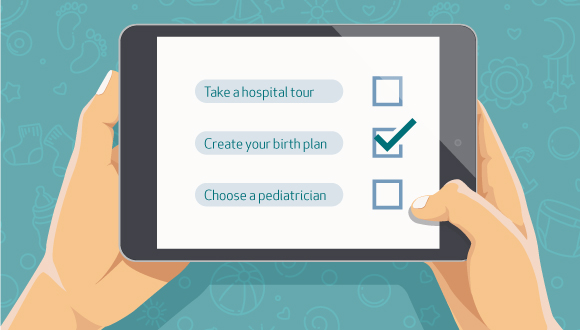Parenting is full of the unexpected, beginning with the timing of your baby's birth.
While you might not be able to know exactly when or how your baby will be born, it doesn't mean you can't be prepared. Creating a birth plan helps you to prepare for your baby's birth by outlining your preferences in advance — and communicating those choices to everyone on your care team.
Plus, your birth plan may look a little different during the COVID-19 pandemic.
"Your birth plan acts as a guide for anyone who provides care throughout your labor and childbirth," says Dr. Kathleen Mundy, OB-GYN at Houston Methodist. "It's a good idea to create your birth plan around 28 weeks, or the beginning of your third trimester of pregnancy, and discuss it with your doctor or midwife so he or she will be aware of the choices you have made."
What to include in your birth plan
Your birth plan will include your preferences for pain relief, atmosphere, who is present and details pertaining to delivery.
"If a woman has very strong preferences, she should talk about them with her provider before creating her birth plan," notes Dr. Jennifer Stanley, OB-GYN at Houston Methodist. "This may clear up any concerns or fears she has, as many techniques and tools only come into play for very specific reasons."
When creating your birth plan checklist, you may want to consider your thoughts on the following:
1. Atmosphere
Will the labor room be dimly lit? Can music be used to create a soothing atmosphere? Are there any spiritual rituals or cultural norms that should be observed?
2. Pain relief
Ask your provider what options are available at the hospital or delivery center. Allow for the possibility that you may change your mind during labor.
3. Who is allowed in the room?
Will your birthing partner be the only person attending? Are there any family members or friends you specifically don't want present? If a cesarean section (C-section) becomes necessary, who can be in the room?
In addition, your hospital may have a visitor policy that restricts the number of visitors you are allowed during the COVID-19 pandemic. And keep in mind that this policy may change or be revised as community spread changes in your area. It's important to stay up-to-date and plan accordingly.
If you are a Houston Methodist patient, you can find our labor and delivery visitor policy here.
4. Delivery plan
Ask your provider about his or her approach to procedures like episiotomies and C-sections. Find out what choices you can make if these become necessary. Also, if you've previously had a C-section, ask if having a vaginal birth after cesarean (VBAC) is an option.
"It's important for expecting mothers to understand that a birth plan is not a substitute for medical decision-making," adds Dr. Stanley. "We do our best to honor every woman's preferences, but ultimately we must do what is the safest choice for mother and child."
5. Documenting the birth
Ask your health care team if your partner will be allowed to take photos or video during the delivery. Hospitals often have policies that dictate this.
6. Cutting the cord
Would you like to cut the umbilical cord yourself or have your partner do it?
7. Cord blood banking
If you're interested in having your baby's cord blood banked for future medical use, it should be outlined in your birth plan.
There's a lot to do when you're preparing to become a parent, and creating a birth plan is just one item on a list of many. While important, don't think you need to spend endless amounts of time preparing your birth plan checklist.
"A highly specific birth plan is less important than open communication — before and throughout the labor experience," says Dr. Mundy.


